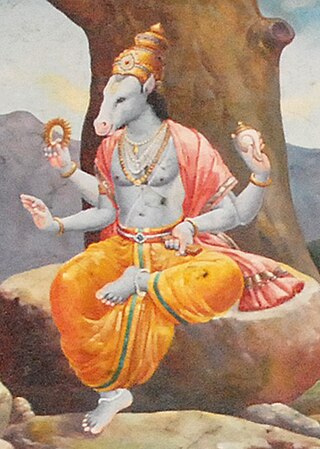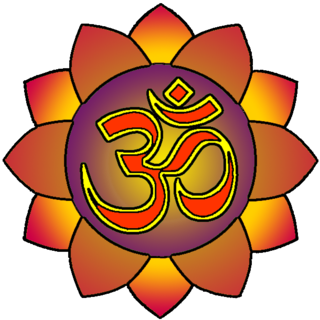
The Upanishads are late Vedic Sanskrit texts that supplied the basis of later Hindu philosophy. They are the most recent part of the Vedas, the oldest scriptures of Hinduism, and deal with meditation, philosophy, consciousness, and ontological knowledge; earlier parts of the Vedas deal with mantras, benedictions, rituals, ceremonies, and sacrifices. While among the most important literature in the history of Indian religions and culture, the Upanishads document a wide variety of "rites, incarnations, and esoteric knowledge" departing from Vedic ritualism and interpreted in various ways in the later commentarial traditions. Of all Vedic literature, the Upanishads alone are widely known, and their diverse ideas, interpreted in various ways, informed the later traditions of Hinduism.

Prajapati is a Vedic deity of Hinduism. In later literature, Prajapati is identified with the creator god Brahma, but the term also connotes many different gods, depending on the Hindu text, ranging from being the creator god to being same as one of the following: Viswakarma, Agni, Indra, Daksha, and many others, reflecting the diverse Hindu cosmology. In classical and medieval era literature, Prajapati is equated to the metaphysical concept called Brahman as Prajapati-Brahman, or alternatively Brahman is described as one who existed before Prajapati.
Uddalaka Aruni, also referred to as Uddalaka or Aruni or Uddalaka Varuni, is a revered Vedic sage of Hinduism. He is mentioned in many Vedic era Sanskrit texts, and his philosophical teachings are among the center piece in the Brihadaranyaka Upanishad and Chandogya Upanishad, two of the oldest Upanishadic scriptures. A famed Vedic teacher, Aruni lived a few centuries before the Buddha, and attracted students from far regions of the Indian subcontinent; some of his students such as Yajnavalkya are also highly revered in the Hindu traditions. Both Aruni and Yajnavalkya are among the most frequently mentioned Upanishadic teachers in Hinduism.

The Dattatreya Upanishad, also called the Dattatreyopanishad, is a Sanskrit text and one of the minor Upanishads of Hinduism. It is attached to the Atharvaveda, and classified as a text of the Vaishnava sect, which worships the god Vishnu.

Hayagriva Upanishad or Hayagrivopanishad is one of 108 Upanishad, written in Sanskrit language. It is a minor Upanishad, dedicated to Hayagriva – the horse-faced avatar of the god Vishnu. It belongs to the Vaishnava sect, which worships Vishnu, and is associated with the Atharvaveda.

The Ekakshara Upanishad, also titled Ekaksharopanishad, is a minor Upanishadic text of Hinduism written in Sanskrit language. It is attached to the Krishna Yajurveda, and is a Samanya (general) Upanishad.

The Sita Upanishad is a medieval era Sanskrit text and a minor Upanishad of Hinduism. It is attached to the Atharva Veda, and is one of the Vaishnava upanishads. It is categorized as a late Upanishad, in which goddess Sita is extolled as the Ultimate Reality of the Universe (Brahman), the ground of Being (Spirituality), and material cause behind all manifestation. The Upanishad identifies Sita with primordial Prakriti (nature) and her three powers, asserts the text, are manifested in daily life as will (ichha), action (kriyā) and knowledge (jnana).

The Nirvana Upanishad is an ancient sutra-style Sanskrit text and a minor Upanishad of Hinduism. The text is attached to the Rig Veda, and is one of the 20 Sannyasa (renunciation) Upanishads. It is a short text and notable for its distilled, aphoristic presentation with metaphors and allegories.
The Sarasvati-rahasya Upanishad, meaning “the Secret Knowledge of the Wisdom Goddess”, is a late medieval era Sanskrit text and one of the minor Upanishads of Hinduism. The text is classified as one of the eight Shakta Upanishads and embedded in the Krishna Yajurveda.
The Tripura Upanishad is a medieval era minor Upanishad of Hinduism. Composed in Sanskrit, the text is classified as a Shakta Upanishad and attached to the Rigveda. It is, as an Upanishad, a part of the corpus of Vedanta literature collection that present the philosophical concepts of Hinduism.

The Bahvricha Upanishad is a medieval era Sanskrit text and one of the minor Upanishads of Hinduism. It is classified as one of the eight Shakta Upanishads and attached to the Rigveda.
Yoga Upanishads are a group of minor Upanishads of Hinduism related to Yoga. There are twenty Yoga Upanishads in the anthology of 108 Upanishads listed in the Muktika anthology. The Yoga Upanishads, along with other minor Upanishads, are generally classified separate from the thirteen major Principal Upanishads considered to be more ancient and from the Vedic tradition.

The Subala Upanishad, also called Subalopanishad (सुबालोपनिषत्), is an Upanishad written in Sanskrit. It is attached to the Shukla Yajurveda, and classified as one of the Samanya Upanishads of Hinduism.

The Bhavana Upanishad is a medieval era minor Upanishad of Hinduism. Composed in Sanskrit, the text is classified as one of the Shakta Upanishads and attached to the Atharvaveda. The Upanishad identifies the human body as Srichakra yantra and elaborates on this theme, and its worship.

The Tripuratapini Upanishad is a medieval era Sanskrit text and one of the minor Upanishads of Hinduism. It is classified as one of the eight Shakta Upanishads and attached to the Atharvaveda.

The Turiyatitavadhuta Upanishad is a medieval era Sanskrit text and is one of the minor Upanishads of Hinduism. The text is attached to the Shukla Yajurveda, and is one of the 20 Sannyasa (renunciation) Upanishads.
Samanya Upanishads or Samanya Vedanta Upanishads are minor Upanishads of Hinduism that are of a generic nature. They were composed later and are classified separate from the thirteen major Principal Upanishads considered to be more ancient and connected to the Vedic tradition.

The Vaishnava Upanishads are minor Upanishads of Hinduism, related to Vishnu theology (Vaishnavism). There are 14 Vaishnava Upanishads in the Muktika anthology of 108 Upanishads. They, along with other minor Upanishads, are generally classified separate from the thirteen major Principal Upanishads considered to be more ancient and from the Vedic tradition.
The Shaiva Upanishads are minor Upanishads of Hinduism, specific to Shiva theology (Shaivism). There are 14 Shaiva Upanishads in the Muktika anthology of 108 Upanishads. They, along with other minor Upanishads, are generally classified separate from the thirteen ancient Principal Upanishads rooted in the Vedic tradition.
Sannyasa Upanishads are a group of minor Upanishads of Hinduism related to the renunciation, monastic practice and asceticism. There are 19 Sannyasa Upanishads in the Muktika anthology of 108 Upanishads. They, along with other minor Upanishads, are generally classified separately from the thirteen major Principal Upanishads considered to be from the ancient Vedic tradition.














